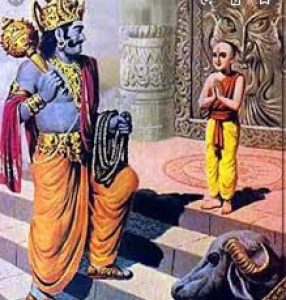Q: To speak of levels or to even say ‘name and form’, isn’t technically correct, is it? There’s only Brahman – period. I ask or say this because it does make a big difference between understanding and ‘living it’.
A: You are right. Pedantically there is only Brahman and even that is saying too much. But all transactions take place in vyavahAra (often referred to as ‘transactional reality’) and that obviously includes the teaching itself. That is why we have words like ‘mithyA’, so we can acknowledge the appearance of duality. We undeniably perceive form and refer to it by name, but acknowledge that it is mithyA – owing its substantial existence to Brahman.
Q: Having this final understanding, does the Mithya go on as:
1. As Ashtavakra Gita says… “a dry leaf being blown in the wind”?
Or
2. An actor knowing he’s an actor and playing roles like a movie?
A: The reasoning behind metaphors is to nudge the mind into appreciating the teaching of something that is counter-intuitive. Once you have ‘got it’, the metaphor should be dropped. The nature of the remainder of the life of a j~nAnI will be dictated by their individual prArabdha karma so will be different for everyone.

 On the insistent questioning of the highly determined Naciketas, Lord Yama had no alternative but to reveal the secret code to ending the transient mortal world and realizing the “immortality” that one actually and already is. It is not some thing new that one acquires. It is prAptasya prAptiH (
On the insistent questioning of the highly determined Naciketas, Lord Yama had no alternative but to reveal the secret code to ending the transient mortal world and realizing the “immortality” that one actually and already is. It is not some thing new that one acquires. It is prAptasya prAptiH (

